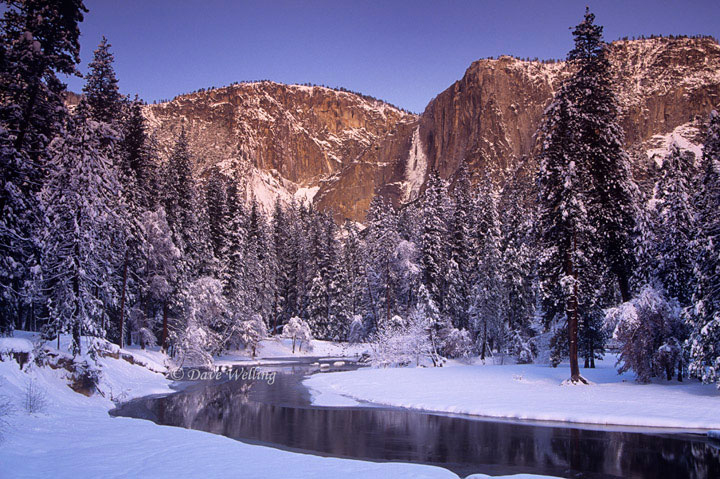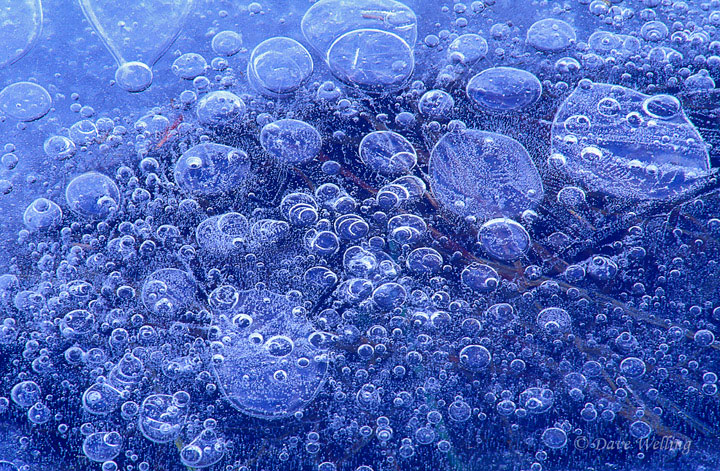You’ve arrived at Yosemite National Park yesterday and captured some great scenic landscapes, like the image of frozen Yosemite Falls and the Merced River draped in a blanket of winter white. You're up early this morning ready to go attack the grand landscape again. But, wait a second… why not change your approach for at least a day? Instead of chasing those grand landscapes, try putting away your wide-angle lenses and pick up your macro and medium lenses to look for those tiny, intimate elements of nature that make up these stunning locations. You will be amazed at the myriad of photo opportunities that you can find.

Camera - Nikon F5s film camera @ ISO40 @ 1/30 sec shutter speed; no flash - natural light. Lens - Nikon 17-35mm wide-angle zoom lens @ F11. Equipment mounted on a Gitzo tripod. Cable release and mirror lock-up used.
Along a quiet stretch of the Merced River I found this fascinating, intimate landscape of frozen bubbles and ice crystals. These frozen bubbles were right along a curve in the river where it slowed almost to a stop, allowing ice to form with great patterns in the water. The color was accentuated with the shade of the deep blue sky, creating an even colder, winter feel (which I was looking for). I set up my camera equipment on my tripod with the lens pointed straight down, and used a large aperture number (equivalent to a small aperture opening) to maximize my range of apparent focus. This keeps as much of the image in focus as possible. Then I adjusted the zoom ring until I had a cropped composition that I found satisfying. I always use mirror lock-up and a cable release in these situations to minimize camera movement and mirror slap, ensuring the sharpest possible image. Now, I had an image from the same location that tells an entirely different story.

Camera - Nikon F5s film camera @ ISO40 @ 1/8 sec shutter speed; no flash - natural light. Lens - Nikon 35-70mm medium range zoom lens @ F18. Equipment mounted on a Gitzo tripod. Cable release and mirror lock-up used.
Not only was there great detail in the water, but in the forest trees and powdery snow banks as well. I found this interesting bud formation hanging from a nearby tree. It was somewhat isolated, giving me a soft green palette in the background; and, the hoarfrost on the bud made it look almost like a Christmas ornament. I switched my wide-angle lens for a 105mm macro lens and went to work. Using my camera's depth-of-field preview I was able to select an aperture that kept most of the bud in focus but with a soft, pleasing background. Again, I used mirror lockup and a cable release to minimize camera shake. There was a slight breeze so I had to wait for several minutes for the bud to become stable in my viewfinder before I pressed the cable release. Now I had an image with yet another completely different feel from the same area.

Camera - Nikon F5s film camera @ ISO40 @ 1/60 sec shutter speed; no flash - natural light. Lens - Nikon 105mm macro lens @ F13. Equipment mounted on a Gitzo tripod. Cable release and mirror lock-up used.
You’ll be surprised what you find, if you look closer!
About the author: Dave Welling is a full time professional photographer specializing in wildlife, landscape and nature with over 75,000 6x7, 6x4.5, and 35mm film and digital images. He has been capturing evocative images of the natural world for over 25 years, producing the highest quality images for publication. His images often capture unique behavioral characteristics of wildlife or special lighting or weather conditions of landscapes. You can see more of his work at www.strikingnatureimagesbydavewelling.com.
Have something to add to the story? Leave a comment or email editor@outdoorphotographyguide.com.

Share tips, start a discussion or ask other students a question. If you have a question for an expert, please click here.
Already a member? Sign in
No Responses to “Intimate Scenes in Travel and Landscape Photos”